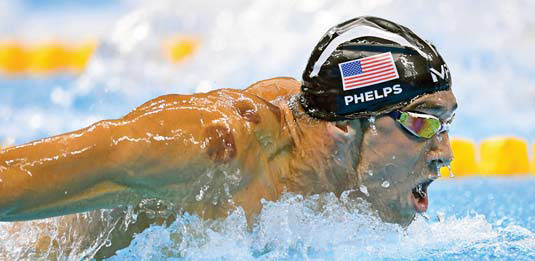Phelps puts the spotlight on cupping
Chinese medicine clinics see surge in calls after Olympic swimmer sports purple-red bruises
Olympic legend Michael Phelps has bagged another hatful of gold medals for the United States swim team in Rio de Janeiro, but what has grabbed media attention around the globe are the purple-red circles on his back.
These, it transpired, were the result of an ancient Chinese treatment known as cupping.
|
US Olympic swimmer Michael Phelps sported deep-purple circles on his shoulder in the 200-meter butterfly semifinal in Rio de Janeiro. Cao Can / Xinhua |
Cupping is done by lighting flammable liquid in a glass cup and placing it on the body. Once the flame goes out, the drop in temperature creates suction, which makes the cups stick. The suction pulls the skin away from the body and promotes blood flow to an area, which reduces muscle tension and inflammation, and promotes healing.
The therapy can cause small blood vessels to burst, leaving the circular bruises seen on Phelps. The marks typically last for three or four days, but can last for weeks.
Brent Bauer, director of the Mayo Clinic Complementary and Integrative Medicine Program, says he received dozens of media requests after Phelps' heroics were aired live on Aug 14.
Yun Li, a licensed acupuncturist in New York, says her clinic, Asia Tui-Na NY, also received many calls about cupping from potential clients.
"We even had patients come in just for cupping. I treat via acupuncture mostly, but there are clients who said, 'Oh I want to just try cupping.'"
Shaobai Wang, a Chinese herbal specialist and an acupuncturist with two clinics in New York, says many clients asked him about cupping, too, primarily to get information on how it actually works.
"In terms of sports injuries - especially muscular ones - the best choice is cupping," he explains. "It's the best choice because it's simple, effective and easy to do without any side effects if utilized correctly. That's why in this Olympic Games there are so many athletes with cupping marks."
Feng Ping, a traditional Chinese medicine doctor who has been practicing in New York for 20 years, says she had clients who talked to her on Aug 16 about Phelps' cupping treatment. "Fifteen years ago, clients didn't believe (in cupping) and would say 'next time' when (I recommended) cupping and acupuncture. Now people would like to try it. Now people know about it."
Julie Ji, a Chinese medical practitioner and a member of the British Acupuncture Council, says the media attention was similar to people's reactions when US actress Gwyneth Paltrow showed up at a movie premiere in 2004 with similar marks on her back. In addition to Paltrow, celebrities such as Jennifer Aniston and Jessica Simpson have also been spotted with the marks.
Chinese athletes often undergo the treatment, Ji says, "so maybe Phelps is learning a trick or two from the Chinese swimmers in 2008," when Beijing hosted the Summer Olympics.
Bauer at the Mayo Clinic says the attention that cupping is getting is good because it makes people ask the right questions.
"The right question is not, 'Gee, I saw something cool on TV. I wonder if I can do that?' The better question is, 'I'm going to do some homework. Cupping appears to be interesting. How does it fit into a traditional Chinese medicine practice? Is it given solo or is it part of a complicated and comprehensive care plan that involves nutrition, exercise, maybe acupuncture?'
"If you can get people to go back and put things in context, then we can have a great discussion."
Amy He and Wang Linyan in New York contributed to this story.
aiheping@chinadailyusa.com



















